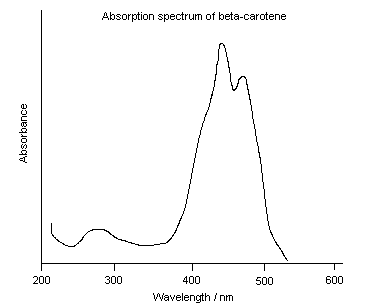Colourings
The conjugated
chain in carotenoids means that they absorb in the visible region and hence
are coloured. The absorption spectrum below shows that beta-carotene
absorbs most strongly between 400-500 nm. This is the green/blue
part of the spectrum. So beta-carotene appears orange, because
the red/yellow colours are reflected back to us.



After Vetter et al. in Carotenoids (ed. O. Isler), Birkhauser Verlag,
1971 , p194
Natural colours
Carotenoids are one of the most important groups of natural pigments. They are responsible for many of the yellow and orange colours of fruit and vegetables. Beta-carotene is most abundant in carrots, of course, but is also found in pumpkins, apricots and nectarines. Dark green vegetables such as spinach and broccoli are another good source. In these the orange colour is masked by the green colour of chlorophyll. This can be seen in leaves; in autumn, when the leaves die, the chlorophyll breaks down, and the yellow/red colours of the more stable carotenoids can be seen.
See
here for more information on natural sources of beta-carotene.
 Natural extracts containing carotenoids, for example carrot extracts and
red palm oil, have been used to colour foods for centuries. Synthetic
beta-carotene was first marketed as a food colouring by Roche in 1954.
It is mainly used for colouring margarine and butter; its
vitamin A activity is an added benefit. Other applications include
ice-cream, fruit juice and the coatings of tablets. Beta-carotene has
an advantage over other artificial colours, for example azo dyes, because
it occurs naturally in food and is so known to be safe.
Natural extracts containing carotenoids, for example carrot extracts and
red palm oil, have been used to colour foods for centuries. Synthetic
beta-carotene was first marketed as a food colouring by Roche in 1954.
It is mainly used for colouring margarine and butter; its
vitamin A activity is an added benefit. Other applications include
ice-cream, fruit juice and the coatings of tablets. Beta-carotene has
an advantage over other artificial colours, for example azo dyes, because
it occurs naturally in food and is so known to be safe.
Artificial colours
 Natural extracts containing carotenoids, for example carrot extracts and
red palm oil, have been used to colour foods for centuries. Synthetic
beta-carotene was first marketed as a food colouring by Roche in 1954.
It is mainly used for colouring margarine and butter; its
vitamin A activity is an added benefit. Other applications include
ice-cream, fruit juice and the coatings of tablets. Beta-carotene has
an advantage over other artificial colours, for example azo dyes, because
it occurs naturally in food and is so known to be safe.
Natural extracts containing carotenoids, for example carrot extracts and
red palm oil, have been used to colour foods for centuries. Synthetic
beta-carotene was first marketed as a food colouring by Roche in 1954.
It is mainly used for colouring margarine and butter; its
vitamin A activity is an added benefit. Other applications include
ice-cream, fruit juice and the coatings of tablets. Beta-carotene has
an advantage over other artificial colours, for example azo dyes, because
it occurs naturally in food and is so known to be safe.|
Home |
Structure |
History |
Synthesis |
Colourings |
Vitamin A |
References |